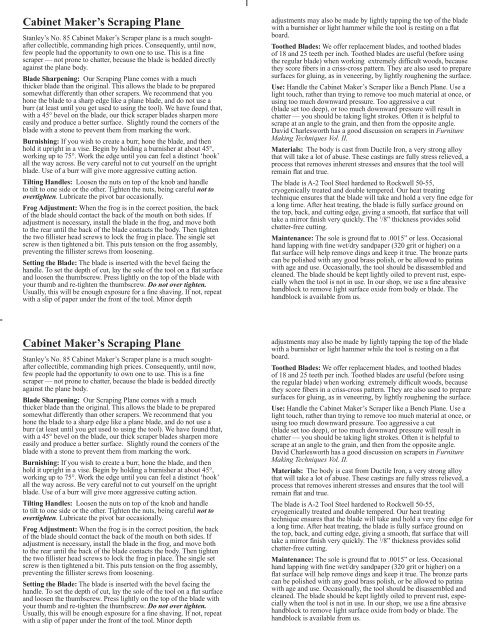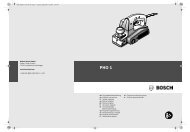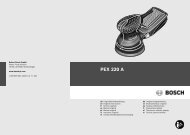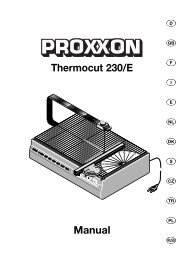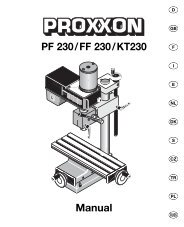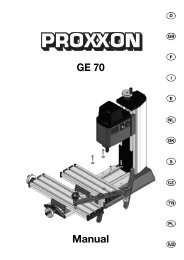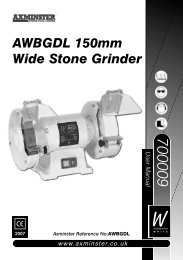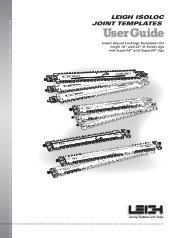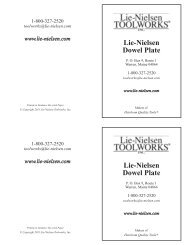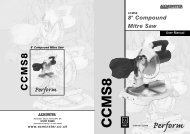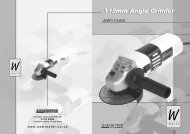85 Cabinet Maker's Scraping Plane.indd - Axminster Tool Centre
85 Cabinet Maker's Scraping Plane.indd - Axminster Tool Centre
85 Cabinet Maker's Scraping Plane.indd - Axminster Tool Centre
You also want an ePaper? Increase the reach of your titles
YUMPU automatically turns print PDFs into web optimized ePapers that Google loves.
<strong>Cabinet</strong> Maker’s <strong>Scraping</strong> <strong>Plane</strong><br />
Stanley’s No. <strong>85</strong> <strong>Cabinet</strong> Maker’s Scraper plane is a much soughtafter<br />
collectible, commanding high prices. Consequently, until now,<br />
few people had the opportunity to own one to use. This is a fi ne<br />
scraper — not prone to chatter, because the blade is bedded directly<br />
against the plane body.<br />
Blade Sharpening: Our <strong>Scraping</strong> <strong>Plane</strong> comes with a much<br />
thicker blade than the original. This allows the blade to be prepared<br />
somewhat differently than other scrapers. We recommend that you<br />
hone the blade to a sharp edge like a plane blade, and do not use a<br />
burr (at least until you get used to using the tool). We have found that,<br />
with a 45° bevel on the blade, our thick scraper blades sharpen more<br />
easily and produce a better surface. Slightly round the corners of the<br />
blade with a stone to prevent them from marking the work.<br />
Burnishing: If you wish to create a burr, hone the blade, and then<br />
hold it upright in a vise. Begin by holding a burnisher at about 45°,<br />
working up to 75°. Work the edge until you can feel a distinct ‘hook’<br />
all the way across. Be very careful not to cut yourself on the upright<br />
blade. Use of a burr will give more aggressive cutting action.<br />
Tilting Handles: Loosen the nuts on top of the knob and handle<br />
to tilt to one side or the other. Tighten the nuts, being careful not to<br />
overtighten. Lubricate the pivot bar occasionally.<br />
Frog Adjustment: When the frog is in the correct position, the back<br />
of the blade should contact the back of the mouth on both sides. If<br />
adjustment is necessary, install the blade in the frog, and move both<br />
to the rear until the back of the blade contacts the body. Then tighten<br />
the two fi llister head screws to lock the frog in place. The single set<br />
screw is then tightened a bit. This puts tension on the frog assembly,<br />
preventing the fi llister screws from loosening.<br />
Setting the Blade: The blade is inserted with the bevel facing the<br />
handle. To set the depth of cut, lay the sole of the tool on a fl at surface<br />
and loosen the thumbscrew. Press lightly on the top of the blade with<br />
your thumb and re-tighten the thumbscrew. Do not over tighten.<br />
Usually, this will be enough exposure for a fi ne shaving. If not, repeat<br />
with a slip of paper under the front of the tool. Minor depth<br />
<strong>Cabinet</strong> Maker’s <strong>Scraping</strong> <strong>Plane</strong><br />
Stanley’s No. <strong>85</strong> <strong>Cabinet</strong> Maker’s Scraper plane is a much soughtafter<br />
collectible, commanding high prices. Consequently, until now,<br />
few people had the opportunity to own one to use. This is a fi ne<br />
scraper — not prone to chatter, because the blade is bedded directly<br />
against the plane body.<br />
Blade Sharpening: Our <strong>Scraping</strong> <strong>Plane</strong> comes with a much<br />
thicker blade than the original. This allows the blade to be prepared<br />
somewhat differently than other scrapers. We recommend that you<br />
hone the blade to a sharp edge like a plane blade, and do not use a<br />
burr (at least until you get used to using the tool). We have found that,<br />
with a 45° bevel on the blade, our thick scraper blades sharpen more<br />
easily and produce a better surface. Slightly round the corners of the<br />
blade with a stone to prevent them from marking the work.<br />
Burnishing: If you wish to create a burr, hone the blade, and then<br />
hold it upright in a vise. Begin by holding a burnisher at about 45°,<br />
working up to 75°. Work the edge until you can feel a distinct ‘hook’<br />
all the way across. Be very careful not to cut yourself on the upright<br />
blade. Use of a burr will give more aggressive cutting action.<br />
Tilting Handles: Loosen the nuts on top of the knob and handle<br />
to tilt to one side or the other. Tighten the nuts, being careful not to<br />
overtighten. Lubricate the pivot bar occasionally.<br />
Frog Adjustment: When the frog is in the correct position, the back<br />
of the blade should contact the back of the mouth on both sides. If<br />
adjustment is necessary, install the blade in the frog, and move both<br />
to the rear until the back of the blade contacts the body. Then tighten<br />
the two fi llister head screws to lock the frog in place. The single set<br />
screw is then tightened a bit. This puts tension on the frog assembly,<br />
preventing the fi llister screws from loosening.<br />
Setting the Blade: The blade is inserted with the bevel facing the<br />
handle. To set the depth of cut, lay the sole of the tool on a fl at surface<br />
and loosen the thumbscrew. Press lightly on the top of the blade with<br />
your thumb and re-tighten the thumbscrew. Do not over tighten.<br />
Usually, this will be enough exposure for a fi ne shaving. If not, repeat<br />
with a slip of paper under the front of the tool. Minor depth<br />
adjustments may also be made by lightly tapping the top of the blade<br />
with a burnisher or light hammer while the tool is resting on a fl at<br />
board.<br />
Toothed Blades: We offer replacement blades, and toothed blades<br />
of 18 and 25 teeth per inch. Toothed blades are useful (before using<br />
the regular blade) when working extremely diffi cult woods, because<br />
they score fi bers in a criss-cross pattern. They are also used to prepare<br />
surfaces for gluing, as in veneering, by lightly roughening the surface.<br />
Use: Handle the <strong>Cabinet</strong> Maker’s Scraper like a Bench <strong>Plane</strong>. Use a<br />
light touch, rather than trying to remove too much material at once, or<br />
using too much downward pressure. Too aggressive a cut<br />
(blade set too deep), or too much downward pressure will result in<br />
chatter — you should be taking light strokes. Often it is helpful to<br />
scrape at an angle to the grain, and then from the opposite angle.<br />
David Charlesworth has a good discussion on scrapers in Furniture<br />
Making Techniques Vol. II.<br />
Materials: The body is cast from Ductile Iron, a very strong alloy<br />
that will take a lot of abuse. These castings are fully stress relieved, a<br />
process that removes inherent stresses and ensures that the tool will<br />
remain fl at and true.<br />
The blade is A-2 <strong>Tool</strong> Steel hardened to Rockwell 50-55,<br />
cryogenically treated and double tempered. Our heat treating<br />
technique ensures that the blade will take and hold a very fi ne edge for<br />
a long time. After heat treating, the blade is fully surface ground on<br />
the top, back, and cutting edge, giving a smooth, fl at surface that will<br />
take a mirror fi nish very quickly. The 1 /8” thickness provides solid<br />
chatter-free cutting.<br />
Maintenance: The sole is ground fl at to .0015” or less. Occasional<br />
hand lapping with fi ne wet/dry sandpaper (320 grit or higher) on a<br />
fl at surface will help remove dings and keep it true. The bronze parts<br />
can be polished with any good brass polish, or be allowed to patina<br />
with age and use. Occasionally, the tool should be disassembled and<br />
cleaned. The blade should be kept lightly oiled to prevent rust, especially<br />
when the tool is not in use. In our shop, we use a fi ne abrasive<br />
handblock to remove light surface oxide from body or blade. The<br />
handblock is available from us.<br />
adjustments may also be made by lightly tapping the top of the blade<br />
with a burnisher or light hammer while the tool is resting on a fl at<br />
board.<br />
Toothed Blades: We offer replacement blades, and toothed blades<br />
of 18 and 25 teeth per inch. Toothed blades are useful (before using<br />
the regular blade) when working extremely diffi cult woods, because<br />
they score fi bers in a criss-cross pattern. They are also used to prepare<br />
surfaces for gluing, as in veneering, by lightly roughening the surface.<br />
Use: Handle the <strong>Cabinet</strong> Maker’s Scraper like a Bench <strong>Plane</strong>. Use a<br />
light touch, rather than trying to remove too much material at once, or<br />
using too much downward pressure. Too aggressive a cut<br />
(blade set too deep), or too much downward pressure will result in<br />
chatter — you should be taking light strokes. Often it is helpful to<br />
scrape at an angle to the grain, and then from the opposite angle.<br />
David Charlesworth has a good discussion on scrapers in Furniture<br />
Making Techniques Vol. II.<br />
Materials: The body is cast from Ductile Iron, a very strong alloy<br />
that will take a lot of abuse. These castings are fully stress relieved, a<br />
process that removes inherent stresses and ensures that the tool will<br />
remain fl at and true.<br />
The blade is A-2 <strong>Tool</strong> Steel hardened to Rockwell 50-55,<br />
cryogenically treated and double tempered. Our heat treating<br />
technique ensures that the blade will take and hold a very fi ne edge for<br />
a long time. After heat treating, the blade is fully surface ground on<br />
the top, back, and cutting edge, giving a smooth, fl at surface that will<br />
take a mirror fi nish very quickly. The 1 /8” thickness provides solid<br />
chatter-free cutting.<br />
Maintenance: The sole is ground fl at to .0015” or less. Occasional<br />
hand lapping with fi ne wet/dry sandpaper (320 grit or higher) on a<br />
fl at surface will help remove dings and keep it true. The bronze parts<br />
can be polished with any good brass polish, or be allowed to patina<br />
with age and use. Occasionally, the tool should be disassembled and<br />
cleaned. The blade should be kept lightly oiled to prevent rust, especially<br />
when the tool is not in use. In our shop, we use a fi ne abrasive<br />
handblock to remove light surface oxide from body or blade. The<br />
handblock is available from us.


